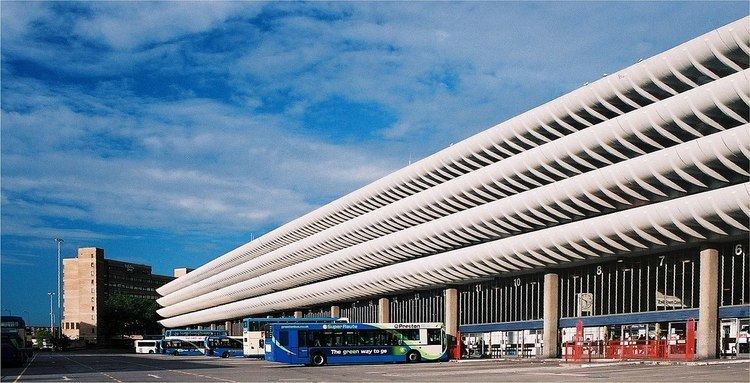Construction started 1968 Architecture firm BDP | Bus stands 80 Opened 12 October 1969 | |
 | ||
Bus operators Preston BusStagecoach Merseyside & South LancashireBlackburn Bus CompanyStagecoach Cumbria & North LancashireMegabusNational Express Official name Preston Central Bus Station and Car Park Address 77 Tithebarn St, Preston PR1 1DJ, UK Similar Harris Museum, Museum of Lancashire, Ribble Steam Railway, Bowland Wild Boar Park, Beacon Fell - Lancashire | ||
56000 a film about preston bus station
Preston Bus Station is the central bus station in the city of Preston in Lancashire, England. It was built by Ove Arup and Partners in the Brutalist architectural style between 1968 and 1969, to a design by Keith Ingham and Charles Wilson of Building Design Partnership with E. H. Stazicker. The building was threatened with demolition as part of the City Council's Tithebarn redevelopment project. After two unsuccessful attempts it was granted Grade II listed building status in September 2013. It is to be redeveloped in association with a new youth centre.
Contents
- 56000 a film about preston bus station
- Cbbc ed london preston bus station girls aloud parody
- Design
- Threatened demolition
- Future use
- Media appearances
- References
Cbbc ed london preston bus station girls aloud parody
Design
Built in the Brutalist architectural style between 1968 and 1969, designed by Keith Ingham and Charles Wilson of Building Design Partnership with E. H. Stazicker, it has a capacity of 80 double-decker buses, 40 along each side of the building. Some claim that it is the second largest bus station in Western Europe. Pedestrian access to the Bus Station is through any of three subways, one of which links directly to the adjacent Guild Hall, while the design also incorporates a multi-storey car park of five floors with space for 1,100 cars. It has been described by the Twentieth Century Society as "one of the most significant Brutalist buildings in the UK".
The building's engineers, Ove Arup and Partners, designed the distinctive curve of the car park balconies "after acceptable finishes to a vertical wall proved too expensive, contributing to the organic, sculptural nature of the building. The edges are functional, too, in that they protect car bumpers from crashing against a vertical wall. The cover balustrade protects passengers from the weather by allowing buses to penetrate beneath the lower parking floor."
Threatened demolition
The building was threatened with demolition as part of the City Council's Tithebarn redevelopment project. After the Tithebarn development collapsed, there were still proposals to demolish the bus station and replace it with a small interchange near the railway station.
In 2000, opposition to demolition led to a failed application for listed building status by English Heritage. Preston Borough Council (as it was then known) opposed the application.
Putting forward the case for a smaller terminus, a report, commissioned by the council and Grosvenor in 2000, stated that "buses arriving and leaving the bus station have very low bus occupancy rates indicating that passengers alight and board elsewhere in the town centre. The bus station car park similarly suffers from the poor pedestrian linkages." Listing was subsequently rejected.
A survey conducted by the Lancashire Evening Post in May 2010 found that Preston Bus Station was Preston people's favourite building.
A further application to list the bus station was rejected in 2010 and a review of the decision was turned down in 2011. It featured on the 2012 World Monument Fund's list of sites at risk.
In 2012, John Wilson of Fulwood in Preston and a member of the "Save Preston Bus Station" campaign presented a petition of 1435 signatures to Preston City Council calling for a referendum on the future of the bus station and argued that 80% of Preston people surveyed supported keeping the bus station and investing in it. Councillors voted to reject a referendum, with only 1 councillor, Terry Cartwright of Deepdale ward voting in favour.
On 7 December 2012, Preston City Council announced that the bus station would be demolished. They said that it would cost £23m to refurbish it and more than £5m just to keep it standing; although they also conceded that demolition would cost an estimated £1.8m. The Twentieth Century Society, which opposes the scheme, have stated that a fraction of this amount would maintain the building while proposals to retain it were being worked up.
In 2013 listed building status was applied for again by English Heritage and this time it was granted Grade II listed building status.
Future use
In October 2014, Lancashire County Council announced plans for a £23m renovation to include "Youth zone" facilities for young people. In August 2015, John Puttick Associates' design was chosen for this scheme.
Media appearances
The station featured in a song on the children's show All Over the Place.
On Good Friday 2012, the bus station was the venue for the Preston Passion, a passion play involving thousands of people forming a 'human cross', broadcast live on BBC Television.
Featured in Bunkers, Brutalism, Bloodymindedness: Concrete Poetry (2014) by Jonathan Meades.
Preston Bus Station is the subject of 56,000, a short film by Paul Adams and Andrew Wilson.
